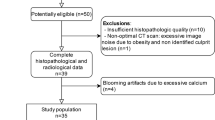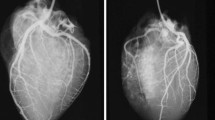Abstract
Post-mortem computed tomography with coronary angiography (PMCTA) could have a role in the investigation of sudden natural death. This study assesses the accuracy of targeted coronary PMCTA, using both air and iodinated contrast media, to provide sensitivity and specificity for critical stenosis (CS) on a segmental basis, based on a gold standard of 3–5 mm serial sections of the coronary arteries using macroscopic and histological techniques. Assessment of stenosis at 1 mm intervals on PMCTA was compared with the data from pathological analysis. Stenosis was defined as “critical” when the stenotic region reaches ≥75 %. Regions were defined every 20 mm or by a clear change in stenosis. Discrepancies were defined as significant if only one test showed CS. Five cases with 25 vessels with 124 regions were assessed. PMCTA was unable to identify plaque hemorrhage or dissection (but this was normally associated with CS). Eighteen segments had significant discrepancies, giving a sensitivity and specificity of 50 and 91.5 %. When an alternative gold standard was constructed by excluding regions beyond a CS (five cases), taking PMCTA as correct where a heavily calcified vessel opens under contrast injection (four cases), and correcting for misregistration of distance (one case), the sensitivity rose to 85.7 %. There was complete agreement when the right or left coronary arteries are assessed as a whole. This study shows that PMCTA is not a perfect replacement for histological examination of coronary vessels, but may have a role in routine post-mortem investigation.





Similar content being viewed by others
References
Dorries C (2004) Coroners’ courts: A guide to law and practice, 2nd edn. Oxford University, Oxford
National Confidential Enquiry into Patient Outcome and Death (2006) The coroner's autopsy: do we deserve better? http://www.ncepod.org.uk/2006Report/Downloads/summary.pdf. Accessed 11 Oct 2012
Roberts IS, Benamore RE, Benbow EW, Lee SH, Harris JN, Jackson A, Mallett S, Patankar T, Peebles C, Roobottom C, Traill ZC (2012) Post-mortem imaging as an alternative to autopsy in the diagnosis of adult deaths: a validation study. Lancet 379(9811):136–142
Wichmann D, Obbelode F, Vogel H, Hoepker WW, Nierhaus A, Braune S, Sauter G, Pueschel K, Kluge S (2012) Virtual autopsy as an alternative to traditional medical autopsy in the intensive care unit a prospective cohort study. Ann Intern Med 156(2):123–130
Roberts WT, Bax JJ, Davies LC (2008) Cardiac CT and CT coronary angiography: technology and application. Heart 94(6):781–792
Winchester DE, Wymer DC, Shifrin RY, Kraft SM, Hill JA (2010) Responsible use of computed tomography in the evaluation of coronary artery disease and chest pain. Mayo Clin Proc 85(4):358–364
Saunders SL, Morgan B, Raj V, Rutty GN (2011) Post-mortem computed tomography angiography: past, present and future. Forensic Sci Med Pathol 7(3):271–277
Sakamoto N, Senoo S, Uemura Y (2009) Case report: cardiopulmonary arrest on arrival case which underwent contrast-enhanced post-mortem CT. J Japan Assoc Acute Med 30:114–115
Lizuka K, Sakamoto N, Kawasaki H, Miyoshi T, Komatuzaki A, Kikuchi S (2009) Usefulness of contrast-enhanced post-mortem CT. Innervision 24:89–92
Grabherr S, Gygax E, Sollberger B, Ross S, Oesterhelweg L, Bolliger S, Christe A, Djonov V, Thali MJ, Dirnhofer R (2008) Two-step postmortem angiography with a modified heart lung machine: preliminary results. Am J Roentgenol 190(2):345–351
Ross S, Spendlove D, Bolliger S, Christe A, Oesterhelweg L, Grabherr S, Thali MJ, Gygax E (2008) Postmortem whole-body CT angiography: evaluation of two contrast media solutions. Am J Roentgenol 190(5):1380–1389
Grabherr S, Djonov V, Yen K, Thali MJ, Dirnhofer R (2007) Postmortem angiography: review of former and current methods. Am J Roentgenol 188(3):832–838
Jackowski C, Persson A, Thali MJ (2008) Whole body postmortem angiography with a high viscosity contrast agent solution using poly ethylene glycol as contrast agent dissolver. J Forensic Sci 53(2):465–468
Jackowski C, Sonnenschein M, Thali MJ, Aghayev E, Allmen G, Yen K, Dirnhofer R, Vock P (2005) Virtopsy: postmortem minimally invasive angiography using cross section techniques—implementation and preliminary results. J Forensic Sci 50(5):1175–1186
Grabherr S, Doenz F, Steger B, Grabherr S, Doenz F, Steger B, Dirnhofer R, Dominguez A, Sollberger B, Gygax E, Rizzo E, Chevallier C, Meuli R, Mangin P (2011) Multi-phase post-mortem CT angiography: development of a standardized protocol. Int J Legal Med 125(6):791–802
Saunders SL, Morgan B, Raj V, Robinson C, Rutty GN (2011) Targeted post-mortem computed tomography cardiac angiography: proof of concept. Int J Legal Med 125(4):609–616
Rutty GN, Saunders S, Morgan B, Raj V (2012) Targeted cardiac post-mortem computed tomography angiography: a pictorial review. Forensic Sci Med Pathol 8(1):40–47
Roberts ISD, Benamore RE, Peebles C, Roobottom C, Traill ZC (2011) Diagnosis of coronary artery disease using a minimally invasive autopsy: evaluation of a novel method of post-mortem coronary CT angiography. Clin Radiol 66(7):645–650
Jackowski C, Hofmann K, Schwendener N, Schweitzer W, Keller-Sutter M (2011) Coronary thrombus and peracute myocardial infarction visualized by unenhanced postmortem MRI prior to autopsy. Forensic Sci Int 214(1–3):e16–e19
Michaud K, Grabherr S, Doenz F, Mangin P (2012) Evaluation of postmortem MDCT and MDCT-angiography for the investigation of sudden cardiac death related to atherosclerotic coronary artery disease. Int J Cardiovasc Imaging 28:1807–1822
Ross SG, Thali MJ, Bolliger S, Germerott T, Ruder TD, Flach PM (2012) Sudden death after chest pain: feasibility of virtual autopsy with postmortem CT angiography and biopsy. Radiology 264(1):250–259
Thomas AC, Davies MJ (1985) Post-mortem investigation and quantification of coronary artery disease. Histopathology 9:959–976
Home Office Policy Advisory Board for Forensic Pathology and the Royal College of Pathologists (2004) Code of practice and performance standards for forensic pathologists. The Royal College of Pathologists. http://www.rcpath.org/Resources/RCPath/Migrated%20Resources/Documents/C/CodeOfPracForensicPath1104.pdf. Accessed 14 June 2012
Champ CS, Coghill SB (1989) Visual aid for quick assessment of coronary artery stenosis at necropsy. J Clin Pathol 42(8):887–888
Topol EJ, Nissen SE (1995) Our preoccupation with coronary luminology—the dissociation between clinical and angiographic findings in ischemic-heart-disease. Circulation 92(8):2333–2342
Little WC, Constantinescu M, Applegate RJ, Kutcher MA, Burrows MT, Kahl FR, Santamore WP (1988) Can coronary angiography predict the site of a subsequent myocardial-infarction in patients with mild-to-moderate coronary-artery disease? Circulation 78(5):1157–1166
Moise A, Lesperance J, Theroux P, Taeymans Y, Goulet C, Bourassa MG (1984) Clinical and angiographic predictors of new total coronary-occlusion in coronary-artery disease—analysis of 313 nonoperated patients. Am J Cardiol 54(10):1176–1181
Arbustini E, Grasso M, Diegoli M, Morbini P, Aguzzi A, Fasani R, Specchia G (1993) Coronary-thrombosis in noncardiac death. Coron Artery Dis 4(9):751–759
Scanlon PJ, Faxon DP, Audet AM, Carabello B, Dehmer GJ, Eagle KA, Legako RD, Leon DF, Murray JA, Nissen SE, Pepine CJ, Watson RM, Ritchie JL, Gibbons RJ, Cheitlin MD, Gardner TJ, Garson A Jr, Russell RO Jr, Ryan TJ, Smith SC Jr (1999) ACC/AHA guidelines for coronary angiography—a report of the American College of Cardiology/American Heart Association Task Force on Practice Guidelines (Committee on Coronary Angiography). J Am Coll Cardiol 33(6):1756–1816
Coghill SB, Nicoll SM, McKimmie A, Houston I, Matthew BM (1983) Revitalising postmortem coronary angiography. J Clin Pathol 36:1406–1409
Acknowledgments
We wish to thank the relatives who gave consent for their recently departed loved ones to be part of this study. We also wish to thank the coroners’ offices of North and South Leicestershire for their support of this project. In addition, we thank the porters, morticians, and radiographers of the University Hospitals of Leicester NHS Trust for their work during this project. We would like to thank Ms A Gillies and L Potter for their help with the processing and sectioning of histology specimens.
This article presents independent research funded by the Department of Health under the NIHR Research for Innovation Speculation and Creativity (RISC) Programme, reference number RC-PG-0409-10052. The views expressed in this publication are those of the authors and not necessarily those of the NHS or the Department of Health.
Conflict of interest
This study has an associated patent pending related to the development of a cadaver-specific angiography catheter and the protocol related to its use.
Author information
Authors and Affiliations
Corresponding author
Additional information
Bruno Morgan and Guy Rutty contributed equally to this paper.
Rights and permissions
About this article
Cite this article
Morgan, B., Biggs, M.J., Barber, J. et al. Accuracy of targeted post-mortem computed tomography coronary angiography compared to assessment of serial histological sections. Int J Legal Med 127, 809–817 (2013). https://doi.org/10.1007/s00414-012-0790-7
Received:
Accepted:
Published:
Issue Date:
DOI: https://doi.org/10.1007/s00414-012-0790-7




